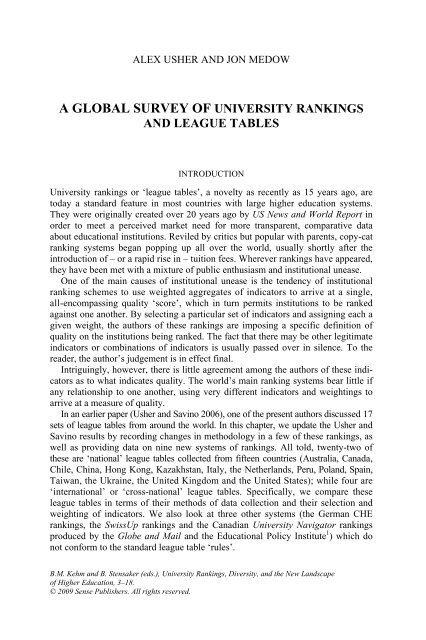University Rankings, Diversity, and the New ... - Sense Publishers
University Rankings, Diversity, and the New ... - Sense Publishers
University Rankings, Diversity, and the New ... - Sense Publishers
Create successful ePaper yourself
Turn your PDF publications into a flip-book with our unique Google optimized e-Paper software.
ALEX USHER AND JON MEDOW<br />
A GLOBAL SURVEY OF UNIVERSITY RANKINGS<br />
AND LEAGUE TABLES<br />
INTRODUCTION<br />
<strong>University</strong> rankings or ‘league tables’, a novelty as recently as 15 years ago, are<br />
today a st<strong>and</strong>ard feature in most countries with large higher education systems.<br />
They were originally created over 20 years ago by US <strong>New</strong>s <strong>and</strong> World Report in<br />
order to meet a perceived market need for more transparent, comparative data<br />
about educational institutions. Reviled by critics but popular with parents, copy-cat<br />
ranking systems began popping up all over <strong>the</strong> world, usually shortly after <strong>the</strong><br />
introduction of – or a rapid rise in – tuition fees. Wherever rankings have appeared,<br />
<strong>the</strong>y have been met with a mixture of public enthusiasm <strong>and</strong> institutional unease.<br />
One of <strong>the</strong> main causes of institutional unease is <strong>the</strong> tendency of institutional<br />
ranking schemes to use weighted aggregates of indicators to arrive at a single,<br />
all-encompassing quality ‘score’, which in turn permits institutions to be ranked<br />
against one ano<strong>the</strong>r. By selecting a particular set of indicators <strong>and</strong> assigning each a<br />
given weight, <strong>the</strong> authors of <strong>the</strong>se rankings are imposing a specific definition of<br />
quality on <strong>the</strong> institutions being ranked. The fact that <strong>the</strong>re may be o<strong>the</strong>r legitimate<br />
indicators or combinations of indicators is usually passed over in silence. To <strong>the</strong><br />
reader, <strong>the</strong> author’s judgement is in effect final.<br />
Intriguingly, however, <strong>the</strong>re is little agreement among <strong>the</strong> authors of <strong>the</strong>se indicators<br />
as to what indicates quality. The world’s main ranking systems bear little if<br />
any relationship to one ano<strong>the</strong>r, using very different indicators <strong>and</strong> weightings to<br />
arrive at a measure of quality.<br />
In an earlier paper (Usher <strong>and</strong> Savino 2006), one of <strong>the</strong> present authors discussed 17<br />
sets of league tables from around <strong>the</strong> world. In this chapter, we update <strong>the</strong> Usher <strong>and</strong><br />
Savino results by recording changes in methodology in a few of <strong>the</strong>se rankings, as<br />
well as providing data on nine new systems of rankings. All told, twenty-two of<br />
<strong>the</strong>se are ‘national’ league tables collected from fifteen countries (Australia, Canada,<br />
Chile, China, Hong Kong, Kazakhstan, Italy, <strong>the</strong> Ne<strong>the</strong>rl<strong>and</strong>s, Peru, Pol<strong>and</strong>, Spain,<br />
Taiwan, <strong>the</strong> Ukraine, <strong>the</strong> United Kingdom <strong>and</strong> <strong>the</strong> United States); while four are<br />
‘international’ or ‘cross-national’ league tables. Specifically, we compare <strong>the</strong>se<br />
league tables in terms of <strong>the</strong>ir methods of data collection <strong>and</strong> <strong>the</strong>ir selection <strong>and</strong><br />
weighting of indicators. We also look at three o<strong>the</strong>r systems (<strong>the</strong> German CHE<br />
rankings, <strong>the</strong> SwissUp rankings <strong>and</strong> <strong>the</strong> Canadian <strong>University</strong> Navigator rankings<br />
produced by <strong>the</strong> Globe <strong>and</strong> Mail <strong>and</strong> <strong>the</strong> Educational Policy Institute 1 ) which do<br />
not conform to <strong>the</strong> st<strong>and</strong>ard league table ‘rules’.<br />
B.M. Kehm <strong>and</strong> B. Stensaker (eds.), <strong>University</strong> <strong>Rankings</strong>, <strong>Diversity</strong>, <strong>and</strong> <strong>the</strong> <strong>New</strong> L<strong>and</strong>scape<br />
of Higher Education, 3–18.<br />
© 2009 <strong>Sense</strong> <strong>Publishers</strong>. All rights reserved.














